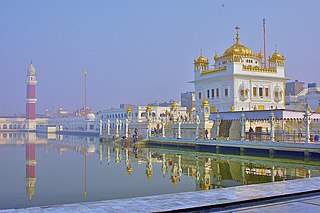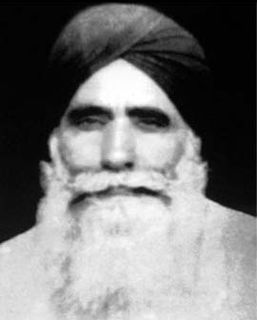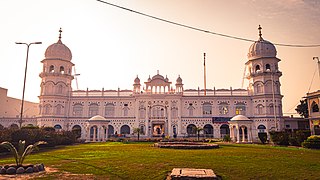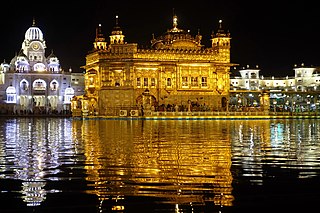
Nankana Sahib is a city and capital of Nankana Sahib District in the Punjab province of Pakistan. It is named after the first Guru of the Sikhs, Guru Nanak, who was born in the city and first began preaching here. Nankana Sahib is the most important religious site for the Sikh religion. It is located about 91 km (57 mi) west of Lahore and about 75 km (47 mi) east of Faisalabad. According to the census of 2017 the city has a population of 79,540 inhabitants. Until 2005, it was the part of Sheikhupura District.
A gurdwara is a place of assembly and worship for Sikhs. Sikhs also refer to gurdwaras as Gurdwara Sahib. People from all faiths are welcomed in gurdwaras. Each gurdwara has a Darbar Sahib where the current and everlasting guru of the Sikhs, the scripture Guru Granth Sahib, is placed on a takhat in a prominent central position. The raagis recite, sing, and explain the verses from the Guru Granth Sahib, in the presence of the congregation.

The Guru Granth Sahib Ji is the central religious scripture of Sikhism, regarded by Sikhs as the final, sovereign and eternal living Guru following the lineage of the ten human gurus of the religion. The Adi Granth, its first rendition, was compiled by the fifth guru, Shri Guru Arjan Dev Ji (1564–1606). Its compilation was completed on 29 August 1604 and first installed inside Golden Temple in Amritsar on 1 September 1604. Baba Buddha Ji was appointed the first Granthi of the Golden Temple. Later, Shri Guru Gobind Singh Ji, the tenth Sikh guru, added hymns of Guru Tegh Bahadur Ji to the Adi Granth and affirmed the text as his successor. This second rendition became known as “The Guru Granth Sahib”, and is also sometimes referred to as the Adi Granth.

Guru Har Krishan was the eighth of the ten Sikh Gurus. At the age of 5, he became the youngest Guru in Sikhism on 7 October 1661, succeeding his father, Guru Har Rai. He contracted smallpox in 1664 and died before reaching his eighth birthday. It is said that he died because he contracted smallpox while successfully curing his followers.

Pratap Singh Giani was a Sikh academician, scholar and calligraphist.

Tarn Taran Sahib is a city in the Majha region of the state of Punjab, in northern India. It is the district headquarters and hosts the municipal council of Tarn Taran district. Gurdwara Sri Tarn Taran Sahib, a prominent Sikh shrine is located in the central part of the city. Near the famous oldest city in Tarn Taran called mattewal. The village of Dilpreet Singh Randhawa who won the gold medal in summer Olympic Games.

The Akal Takht is one of five takhts of the Sikhs. It is located in the Harmandir Sahib complex in Amritsar, Punjab, India. The Akal Takht was built by Shri Guru Hargobind as a place of justice and consideration of temporal issues; the highest seat of earthly authority of the Khalsa and the place of the Jathedar, the highest spokesman of the Sikhs. The current Jathedar of Akal Takht appointed by the SGPC is Giani Harpreet Singh, while the Sarbat Khalsa calls for the reinstitution of Jagtar Singh Hawara.

Batala is the eighth largest city in the state of Punjab, India in terms of population after Ludhiana, Amritsar, Jalandhar, Patiala, Bathinda, Mohali and Hoshiarpur. Batala ranks as the second-oldest city after Bathinda. It is a municipal corporation in Gurdaspur district in the Majha region of the state of Punjab, India. It is located about 32 km from Gurdaspur, the headquarters of the district. It is also a Police District. Batala holds the status of the most populated town of the district with 31% of the total population of district. It is the biggest industrial town in the district. Batala is the centre of the Majha region of Punjab.

Guru Nanak Dev Ji Gurpurab, also known as Guru Nanak's Prakash Utsav and Guru Nanak Dev Ji Jayanti, celebrates the birth of the first Sikh guru, Guru Nanak. One of the most celebrated Sikh gurus and the founder of Sikhism, Guru Nanak Dev is highly revered by the Sikh community. This is one of the most sacred festivals in Sikhism, or Sikhi.
The Namdharis are a separate Sikh sect that differs from mainstream Sikhs in the belief that the lineage of Sikh Gurus did not end with Guru Gobind Singh. They believe that Guru Gobind Singh stealthily escaped the burning tent in Nanded, and secretly helped the Khalsa in the coming decades under the guise of Baba Ajaypal Singh. According to their beliefs, Guru Gobind Singh passed guruship to Satguru Balak Singh of Hazro, Punjab in the year 1812 on Baisakh Sudi 10. Therefore, they recognize Satguru Balak Singh as the 11th Guru of the Sikh religion, thus continuing the succession of Sikh Gurus through the centuries from Guru Nanak Dev Ji to Namdhari Satguru Jagjit Singh. Guru Gobind Singh shortly retired from this world leaving his earthly body on Jeth Sudi 5, Vikrami Samvat 1869. The 12th Guru is Satguru Ram Singh, who moved the sects centre to Bhaini Sahib (Ludhiana) and is regarded as the first Indian to use non-cooperation and non-violence boycott in order to combat the tyrannous British Empire in India, while being an advocate for women's rights, and reviving the failing Khalsa traditions of Guru Gobind Singh.

Bhai Mani Singh was an 18th-century Sikh scholar and martyr. He was a childhood companion of Guru Gobind Singh and took the vows of Sikhism when the Guru inaugurated the Khalsa in March 1699. Soon after that, the Guru sent him to Amritsar to take charge of Harmandir Sahib, which had been without a custodian since 1696. He took control and steered the course of Sikh destiny at a critical stage in Sikh history.

Majha is a region located in the central parts of the historical Punjab region split between India and Pakistan. It extends north from the right banks of the river Beas, and reaches as far north as the river Jhelum. People of the Majha region are given the demonym "Mājhī", or the more widely used Majhail. Most inhabitants of the region speak the Majhi dialect, which is the basis of the standard register of the Punjabi language. The most populous city in the area is Lahore on the Pakistani side and Amritsar on the Indian side of the border.
Sikhism was coined by Guru Gobind Singh Ji. He was the tenth Guru of the 17 century in the Punjab region in the northern part of the Indian subcontinent. The Faith practices were formalised by Guru Gobind Singh Ji on 13 April 1699. The latter baptised five Sikh people from different parts of India and had different social backgrounds to form Khalsa (ਖ਼ਾਲਸਾ). The first five, Pure Ones, then baptised Gobind Singh ji into the Khalsa fold. This gives the order of Khalsa, a history of around 300 years.
Baghel Singh was a military general in the Punjab region in the northern part of the Indian subcontinent in the 18th century. He rose to prominence in the area around Sutlej and Yamuna. Singh joined the Singh Krora Misl, one of the misls during Sikh Confederacy. In 1765, Singh became the leader of the misl.

Teja Singh Akarpuri was an Indian and Sikh politician who served as the 11th Jathedar of Akal Takht from 1921 to 1923 and 1926 to 1930. He was the First MP from Gurdaspur constituency In Lok Sabha from 1952 to 1957 and was succeeded by Diwan Chand Sharma
The Sikhs are adherents to Sikhism the fifth largest organized religion in the world, with around 25 million adherents. Sikh History is around 500 years and in that time the Sikhs have developed unique expressions of art and culture which are influenced by their faith and synthesize traditions from many other cultures depending on the locality of the adherents of the religion. Sikhism is the only religion that originated in the Punjab region with all other religions coming from outside Punjab. All the Sikh gurus, many saints and many of the martyrs in Sikh history were from Punjab and from the Punjabi people. Punjabi culture and Sikhism are mistakenly considered inseparably intertwined. "Sikh" properly refers to adherents of Sikhism as a religion, strictly not an ethnic group. However, because Sikhism has seldom sought converts, most Sikhs share strong ethno-religious ties as therefore it's a common stereotype that all Sikhs share the same ethnicity. Many countries, such as the U.K., therefore misconcievingly recognize Sikh as a designated ethnicity on their censuses. The American non-profit organization United Sikhs has fought to have Sikh included on the U.S. census as well, arguing that Sikhs "self-identify as an 'ethnic minority'" and believe "that they are more than just a religion".

Guru Nanak, also referred to as Baba Nanak, was the founder of Sikhism and is the first of the ten Sikh Gurus. His birth is celebrated worldwide as Guru Nanak Gurpurab on Katak Pooranmashi, i.e. October–November.

Gurdwara Janam Asthan, also referred to as Gurdwara Nankana Sahib, is a highly revered gurdwara that was built at the site where the founder of Sikhism, Guru Nanak, was believed to be born. The shrine is located in the city of Nankana Sahib, near the city of Lahore in the Punjab province of Pakistan.

The Golden Temple, also known as Harmandir Sahib, meaning "abode of God" or Darbār Sahib, meaning "exalted court", is a gurdwara located in the city of Amritsar, Punjab, India. It is the preeminent spiritual site of Sikhism.

Hazur Sahib, also known as Takht Sachkhand Sri Hazur Abchalnagar Sahib, is one of the five takhts in Sikhism. It is located on the banks of the Godavari River at the city of Nanded in the state of Maharashtra, India. The gurdwara within the complex is known as Sach-Khand.














